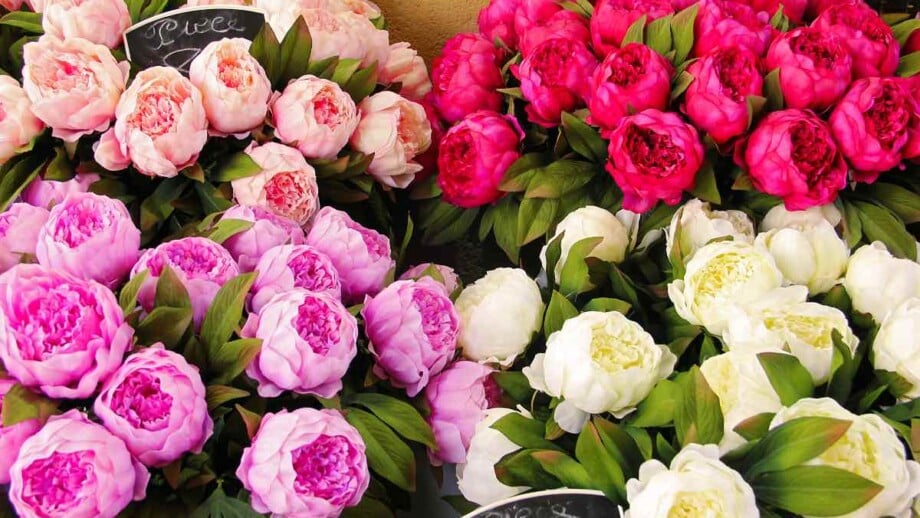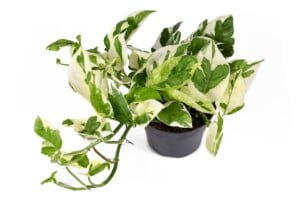Peonies are one of the greatest pleasures of late spring and early summer thanks to their stunning and abundant flowers. These long-lived perennials are also simple to grow and won’t require much maintenance throughout the years. Peonies are the flowers of the genus Paeonia, which has as many as 33 distinct species!
They make excellent cut flowers and are particularly popular in bridal bouquets. The glossy, eye-catching leaves are perfect for borders or walkways since they maintain their green color long after the peonies’ flowers have faded. Plus, their incredible fragrance is sure to win some hearts along the way!
The peony, which is the state flower of Indiana, is widely considered to be one of the most stunning flowers in the world. But that’s not all, these stunning blooms also hold symbolic meaning and value.
To the Chinese, it is the ‘king of flowers,’ representing regality and virtue. Many people also think of the peony as a sign of honor, wealth, good fortune, and vitality. Because of its rich symbolism, the flower is commonly used to usher in the Chinese New Year.
In addition to their smell and abundant availability as cut flowers, peonies are a popular option for brides because of their symbolic meaning. They signify romance and love and are said to be a positive omen of a happy marriage.
Botanical Name: Paeonia spp.
Common Name: Peony, peonies,
Family: Paeoniaceae
Plant Type: Herbaceous perennial, woody shrub
Hardiness Zones: 3 to 8 (USDA)
Sun Exposure: Full sun
Soil Type: Well-draining
Soil pH: 6.5 to 7.0 (Neutral)
Height: 2 to 3 feet tall
Spacing: 3 to 4 feet apart
Bloom Time: Spring, summer
Flower Colors: Pink, rose, red, white, coral, and deep purple
Native Area: Europe, Asia, and Western North America
Quick Guide: Planting, Growing & Caring for Peonies
- Peonies are stunning, showy flowers that bloom from late spring through early summer.
- These flowering plants do best when they receive 6 to 8 hours of sunlight per day.
- Although peonies are quite adaptable, they prefer slightly acidic and well-draining soil. Tree peony varieties prefer soil that is slightly more acidic than regular herbaceous peonies.
- They should ideally receive 1 to 2 inches of water every week and are not drought-resistant.

Peony Flower Plant Care
Peonies are the showy spring bloomers in your garden. These are traditional garden plants that can grow for decades with little care if planted in suitable soil.
The majority are herbaceous perennials, with a few being woody shrubs. Peonies are medium-sized flowers that grow from tuberous roots that are both large store roots and thin roots adapted to take up water and nutrients.
Careful care of these roots is essential when planting or transplanting peonies, as well as when propagating them by dividing plants.
Depending on the variety, peonies bloom between late spring and late summer, although it is preferable to plant them all in the fall, approximately six weeks before the ground freezes. This allows the plant sufficient time to grow roots before winter.
This is especially true when transplanting or planting bare-root peonies, but fall planting produces better results than spring planting even when planting potted peonies.
Light
Although they can survive in partial shade, peonies like full sun, and they flower at their best in an area that receives 6 to 8 hours of sunlight per day.
Peonies can be blown over by strong winds because their large blooms make them top heavy. So it’s important to provide shelter against such winds.
Without adequate sunlight, there will be fewer blossoms and smaller flowers, and plants will be more susceptible to fungal diseases.
Soil
While peonies are quite adaptable, their preferred soil is well-drained and slightly acidic (6.5-7.0 pH).
Amending the soil with compost or a soil mix designated for azaleas and rhododendrons can make it easier for your peony plant to establish itself if you are planting in thick, clay soil. Tree peonies like soil that is slightly more acidic than regular herbaceous peonies, and they don’t like to grow near other shrubs.
Since peonies can grow in the same location for up to 70 years, it is worthwhile to spend time preparing the soil before planting.
Water
Peonies do best in moist, well-drained soil. They should ideally receive 1 to 2 inches of water every week. They can grow well in places that are relatively wet, but they don’t do well in dry areas since they’re not drought-resistant.
Mulch your peony to help them retain water and reduce weed growth.
Temperature and Humidity
Peonies favor milder climates (particularly hardiness zones 3-8) and thrive in cold winters. They won’t grow in hot climates since they require a period of cold with temperatures below 40 degrees for at least six weeks. In general, they thrive best when they experience cold winters.
Fertilizer
Feed your peonies with fertilizer sparingly. All that is required is an annual application of compost combined with a very little amount of fertilizer around the base of the plant. Feed the plants with compost and fertilizer only after they have finished blooming.
In the winter, avoid covering peonies with mulch. You can lightly mulch with pine needles or crushed bark during the first winter season, but mulch needs to be removed as soon as spring arrives.
Fertilizing tree peonies with sulfate and bone meal once yearly in the spring helps them get the iron and phosphate they need to thrive. In contrast to herbaceous peonies, these types of peonies require fertilizer with a ratio of 5-10-5 on a regular basis.
Pruning
Peonies don’t require much pruning. Once it has done blooming, prune off any dead stems or branches. In the event that a stem looks to be infected, it should be pruned back before the diseased area.
If two branches are rubbing against one another, remove the less attractive of the two. Always prune peonies to just above the first bud while doing so.

Types of Peonies
Peonies are popular because of their vivid, colorful flowers and the vast range of shapes and sizes they come in. Let’s look at each of the three main types of peony in more detail:
Herbaceous Peonies: The most common and well-known type is the herbaceous peonies (Paeonia lactiflora). These are perennial plants that die down to the ground in the winter and then reappear in the spring with lush foliage and beautiful flowers. Herbaceous peonies are popular among gardeners because they are hardy and easy to grow.

Tree Peonies: Tree peonies (Paeonia suffruticosa) are woody, deciduous shrub peonies. In the fall, they shed their foliage, but unlike herbaceous peonies, their woody branches do not die back to the ground.

Itoh Peonies: Itoh peonies (intersectional peonies) are a cross between herbaceous and tree peonies, created by the Japanese breeder Toichi Itoh in the mid-20th century. They combine the best traits of both types of peonies, with the hardiness and ease of care of herbaceous peonies, and the large, colorful flowers of tree peonies.

When Do Peonies Bloom?
Peony season is determined by your location and the variety you are cultivating. Peonies typically bloom from late spring through early summer.
Several nurseries provide early, midseason, and late blooming kinds, allowing you to extend the peony season and enjoy those wonderful blossoms for as long as possible!
Blooming order will likely be as follows: tree peonies first (around Mother’s Day), herbaceous varieties second (about Memorial Day), and intersectional varieties third. If you plant all three, you can enjoy flowers for up to seven weeks.

Popular Varieties of Peony Flowers
Here are a few stunning varieties you might want to check out and consider planting:
- ‘Border Charm’ is a hybrid of a tree peony and a herbaceous plant. It blooms with sunny yellow flowers on stalks that top out at just 22 inches.
- ‘Karl Rosenfield’ was first grown in 1908, and it is one of the most popular red peonies ever. It grows to a height of 32 inches and has double blooms.
- ‘Festiva Maxima’ is a popular heirloom from the 1850s. It produces beautiful white flowers with crimson specks and a captivating rose-like fragrance on 3-foot shrubs.
- ‘Sarah Bernhardt’ is a renowned heirloom from 1909 named after a famous actress from that time. It features delicate, double, pink flowers with a lovely scent.


How to Plant and Grow Peonies
Site Preparation
It’s important to plant peonies correctly the first time because they don’t like to be moved once they are established. Pick a sunny spot for your peonies and prepare the site according to the type of peony you’re growing.
If you are planting your peony in thick clay soil, adding compost or a soil mix for azaleas and rhododendrons can make it easier for the plant to take root. Tree peonies like slightly more acidic soil than regular herbaceous peonies, and they don’t like to grow near other shrubs.
How to Plant Peony Flowers
Most peonies are sold as bare-root tubers with 3 to 5 eyes (buds) that come from plants that are 3 or 4 years old.
Peonies should be placed 3 to 4 feet apart to allow for enough air circulation. Air that is stagnant and humid can be a breeding ground for disease.
In a sunny area, dig a generously sized hole that is about 2 feet deep and 2 feet wide. Including organic matter in the planting hole will be beneficial for the soil. If the soil is dense or extremely sandy, amend it with additional compost.
The roots should be positioned in the hole just 2 inches below the soil’s surface, with the root’s eyes facing upward on top of a mound of soil. Avoid planting too deeply! Choose early-blooming species, plant them approximately 1 inch deep, and provide some shade in southern states.
Then, carefully backfill the hole, ensuring that the soil does not settle, and bury the root deeper than 2 inches. Lightly tamp the soil.
Cover a container-grown peony no deeper than it grew in the pot when planting it. At the time of planting, water your new peonies thoroughly.
Common Pests and Plant Diseases for Peonies
Peonies are often resilient and resistant to pests and diseases, but they can be susceptible to a few common problems.
They are particularly vulnerable to powdery mildew and botrytis blight. You can avoid this by ensuring that the area around your peony plants has good air circulation. Also, keep an eye out for Japanese beetles that can also affect peonies.
Gardeners frequently find ants on peony petals, which are drawn to the nectar generated by the very fragrant flowers. The ants don’t hurt the plant, and in fact, they can keep away other insects that eat flowers and might carry disease or do other damage.
But of course, you’re probably not going to be too fond of the ants in your cut flower bouquets. So, before bringing your freshly cut peonies inside, give them a gentle shake to get rid of the ants.
Other Flower Guides from Planet Natural:
Blue Orchids: Real and Fake – All Your Questions Answered











